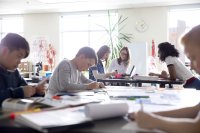8 Principles of Deeper Learning
Key elements that teachers can use in instructional design to guide students to engage more deeply with content.
As educators we all recognize the importance of sparking a student’s curiosity and motivation to learn. We know that when students are provided with opportunities to undertake meaningful tasks to solve real-world problems, engagement soars.
But teachers today are under a great deal of pressure to cover standards so that students pass a test that measures proficiency. In many cases, curriculum and instruction have been stifled by strict pacing guides and a focus on discrete learning.
I collaborate with educators weekly who share the deeper learning that can be achieved when they are empowered to design meaningful learning experiences for the students they serve. Teachers share lessons that are authentic, hands-on, challenging, and purposeful. These lessons address more than standards: They focus on many of the soft skills we know are critical for student success in college, career, and life—skills such as being able to collaborate, create, solve problems, communicate effectively, and persevere in tasks.
There are actions we can take now to empower teachers to achieve these deeper levels of learning. Through intentional instructional design we can guide students to think critically about arguments, concepts, and ideas and to create solutions to real-world problems.
8 Steps to Deeper Learning
1. Learning goals and success criteria: Any great lesson begins with clear goals for what students need to know and be able to do. Goals, coupled with criteria for success, should be communicated to students in a manner that clarifies our expectations and serves as a guide for self-assessment.
2. Compelling content and products: Beyond discrete standards, teachers have the opportunity to use content and performance expectations to create real-world problems or situations for students to solve. Learning experiences that offer authentic, interdisciplinary tasks provide relevance and promote curiosity for students.
3. Collaborative culture: Learning is social, and the purposeful inclusion of collaboration throughout the learning process is highly engaging for students. There are endless design options for collaboration, including flexible groups, partners, peer tutoring, Socratic seminars, academic discussion, and online experts.
4. Student empowerment: Students’ ownership of their learning increases exponentially when they’re given choice over how to show mastery or create a final product or performance, including using digital tools and resources. Additionally, inviting students to provide input into what they learn and how they engage with content allows them to play the role of co-designer.
5. Intentional instruction: Evidence-based strategies should be carefully selected in order to have the greatest impact on the learning goals. One such strategy is the gradual release of responsibility (GRR) model, which provides structure for direct instruction and modeling (“show them”) and guided practice on a task (“help them”), before students attempt it independently (“let them”).
6. Authentic tools and resources: Students should have access to a variety of tools and resources, both print and digital, throughout the learning process and when creating products to demonstrate their learning. Providing a variety of tools offers students choice and emphasizes process over product. Digital strategies such as blended learning and flipped classrooms offer rich experiences that are highly engaging and honor how students like to learn and create.
7. Focus on literacy: Regardless of the content, reading, writing, and speaking should be incorporated into every learning experience. Expose students to multiple texts, primary and secondary sources, and online resources. Engage students in opportunities to write often—e.g., by assigning lab reports, technical manuals, narrative stories, research summaries, opinion papers, or interactive notebooks.
8. Feedback for learning: Throughout the learning experience, there are feedback loops to give students guidance on their progress toward the learning goals. This feedback can be teacher-to-student, student-to-student, or self-assessment. Feedback is formative and provides students with the safety and security of knowing they can take risks and try new things without fear of failure.
A Deeper Learning Lesson
Here’s a lesson that shows how these elements come together, using “Thank You, Ma’am,” by Langston Hughes, a story with two characters: Roger, a teenage boy who wants a pair of shoes and attempts to steal the purse of Luella Jones. The learning goals for the lesson are to cite textual evidence, analyze how an author develops the points of view of different characters, and write arguments to support claims with logical reasoning and relevant evidence.
Have students think of Roger as a juvenile offender appearing in court for violation of probation, including charges of attempted theft, harassment, assault, and breaking curfew. Provide background knowledge about the court system and the procedures for a hearing—this can be done with videos, a video call with local officials, or even a trip to the local courthouse.
Assume that Roger is a student at a local school and lives in a group home for children with no families. Students will take on one of the following roles and determine whether to prosecute or defend Roger: a parole officer, a social worker, or a son or daughter of Luella Jones.
They will prepare a minimum three-paragraph opinion for the judge and jury, citing at least three pieces of evidence to support their position for or against Roger. There are multiple opportunities to explore themes of shame and forgiveness, as well as empathy, throughout this experience.
Students next collaborate with others in class who chose the same role, sharing their arguments and evidence. They then make revisions to their argument and practice presenting their opinion with their group, brainstorming possible questions that could be asked during a trial.
You should then run the trial a couple of times, so that every student participates at least once as either judge, jury, prosecution, or defense.
This plan for instruction makes the learning a memorable experience. Students are provided with an authentic problem that provides purpose and a context for learning.
